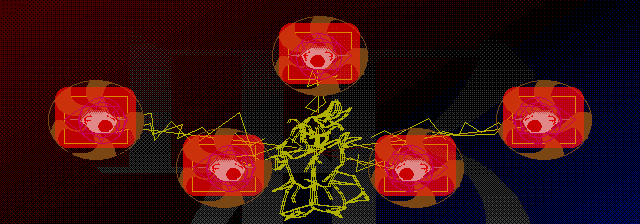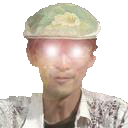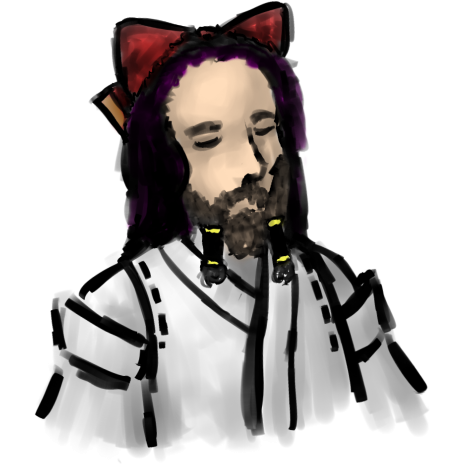- 📝 Posted:
- 🚚 Summary of:
- P0207, P0208, P0209, P0210, P0211
- ⌨ Commits:
454c105...c26ef4b,c26ef4b...239a3ec,239a3ec...5030867,5030867...149fbca,149fbca...d398a94- 💰 Funded by:
- GhostPhanom, Yanga, Arandui, Lmocinemod
- 🏷 Tags:
Whew, TH01's boss code just had to end with another beast of a boss, taking way longer than it should have and leaving uncomfortably little time for the rest of the game. Let's get right into the overview of YuugenMagan, the most sequential and scripted battle in this game:
- The fight consists of 14 phases, numbered (of course) from 0 to 13. Unlike all other bosses, the "entrance phase" 0 is a proper gameplay-enabled part of the fight itself, which is why I also count it here.
- YuugenMagan starts with 16 HP, second only to Sariel's 18+6. The HP bar visualizes the HP threshold for the end of phases 3 (white part) and 7 (red-white part), respectively.
- All even-numbered phases change the color of the 邪 kanji in the stage background, and don't check for collisions between the Orb and any eye. Almost all of them consequently don't feature an attack, except for phase 0's 1-pixel lasers, spawning symmetrically from the left and right edges of the playfield towards the center. Which means that yes, YuugenMagan is in fact invincible during this first attack.
- All other attacks are part of the odd-numbered phases:
- Phase 1: Slow pellets from the lateral eyes. Ends at 15 HP.
- Phase 3: Missiles from the southern eyes, whose angles first shift away from Reimu's tracked position and then towards it. Ends at 12 HP.
- Phase 5: Circular pellets sprayed from the lateral eyes. Ends at 10 HP.
- Phase 7: Another missile pattern, but this time with both eyes shifting their missile angles by the same (counter-)clockwise delta angles. Ends at 8 HP.
- Phase 9: The 3-pixel 3-laser sequence from the northern eye. Ends at 2 HP.
- Phase 11: Spawns the pentagram with one corner out of every eye, then gradually shrinks and moves it towards the center of the playfield. Not really an "attack" (surprise) as the pentagram can't reach the player during this phase, but collision detection is technically already active here. Ends at 0 HP, marking the earliest point where the fight itself can possibly end.
- Phase 13: Runs through the parallel "pentagram attack phases". The first five consist of the pentagram alternating its spinning direction between clockwise and counterclockwise while firing pellets from each of the five star corners. After that, the pentagram slams itself into the player, before YuugenMagan loops back to phase 10 to spawn a new pentagram. On the next run through phase 13, the pentagram grows larger and immediately slams itself into the player, before starting a new pentagram attack phase cycle with another loop back to phase 10.
- Since the HP bar fills up in a phase with no collision detection, YuugenMagan is immune to 📝 test/debug mode heap corruption. It's generally impossible to get YuugenMagan's HP into negative numbers, with collision detection being disabled every other phase, and all odd-numbered phases ending immediately upon reaching their HP threshold.
- All phases until the very last one have a timeout condition, independent
from YuugenMagan's current HP:
- Phase 0: 331 frames
- Phase 1: 1101 frames
- Phases 2, 4, 6, 8, 10, and 12: 70 frames each
- Phases 3 and 7: 5 iterations of the pattern, or 1845 frames each
- Phase 5: 5 iterations of the pattern, or 2230 frames
- Phase 9: The full duration of the sequence, or 491 frames
- Phase 11: Until the pentagram reached its target position, or 221 frames
At a pixel-perfect 81×61 pixels, the Orb hitboxes are laid out rather generously this time, reaching quite a bit outside the 64×48 eye sprites:

And that's about the only positive thing I can say about a position
calculation in this fight. Phase 0 already starts with the lasers being off
by 1 pixel from the center of the iris. Sure, 28 may be a nicer number to
add than 29, but the result won't be byte-aligned either way? This is
followed by the eastern laser's hitbox somehow being 24 pixels larger than
the others, stretching a rather unexpected 70 pixels compared to the 46 of
every other laser.
On a more hilarious note, the eye closing keyframe contains the following
(pseudo-)code, comprising the only real accidentally "unused" danmaku
subpattern in TH01:
// Did you mean ">= RANK_HARD"?
if(rank == RANK_HARD) {
eye_north.fire_aimed_wide_5_spread();
eye_southeast.fire_aimed_wide_5_spread();
eye_southwest.fire_aimed_wide_5_spread();
// Because this condition can never be true otherwise.
// As a result, no pellets will be spawned on Lunatic mode.
// (There is another Lunatic-exclusive subpattern later, though.)
if(rank == RANK_LUNATIC) {
eye_west.fire_aimed_wide_5_spread();
eye_east.fire_aimed_wide_5_spread();
}
}
After a few utility functions that look more like a quickly abandoned
refactoring attempt, we quickly get to the main attraction: YuugenMagan
combines the entire boss script and most of the pattern code into a single
2,634-instruction function, totaling 9,677 bytes inside
REIIDEN.EXE. For comparison, ReC98's version of this code
consists of at least 49 functions, excluding those I had to add to work
around ZUN's little inconsistencies, or the ones I added for stylistic
reasons.
In fact, this function is so large that Turbo C++ 4.0J refuses to generate
assembly output for it via the -S command-line option, aborting
with a Compiler table limit exceeded in function error.
Contrary to what the Borland C++ 4.0 User Guide suggests, this
instance of the error is not at all related to the number of function bodies
or any metric of algorithmic complexity, but is simply a result of the
compiler's internal text representation for a single function overflowing a
64 KiB memory segment. Merely shortening the names of enough identifiers
within the function can help to get that representation down below 64 KiB.
If you encounter this error during regular software development, you might
interpret it as the compiler's roundabout way of telling you that it inlined
way more function calls than you probably wanted to have inlined. Because
you definitely won't explicitly spell out such a long function
in newly-written code, right?
![]()
At least it wasn't the worst copy-pasting job in this
game; that trophy still goes to 📝 Elis. And
while the tracking code for adjusting an eye's sprite according to the
player's relative position is one of the main causes behind all the bloat,
it's also 100% consistent, and might have been an inlined class method in
ZUN's original code as well.
The clear highlight in this fight though? Almost no coordinate is precisely calculated where you'd expect it to be. In particular, all bullet spawn positions completely ignore the direction the eyes are facing to:




Due to their effect on gameplay, these inaccuracies can't even be called "bugs", and made me devise a new "quirk" category instead. More on that in the TH01 100% blog post, though.
While we did see an accidentally unused bullet pattern earlier, I can
now say with certainty that there are no truly unused danmaku
patterns in TH01, i.e., pattern code that exists but is never called.
However, the code for YuugenMagan's phase 5 reveals another small piece of
danmaku design intention that never shows up within the parameters of
the original game.
By default, pellets are clipped when they fly past the top of the playfield,
which we can clearly observe for the first few pellets of this pattern.
Interestingly though, the second subpattern actually configures its pellets
to fall straight down from the top of the playfield instead. You never see
this happening in-game because ZUN limited that subpattern to a downwards
angle range of 0x73 or 162°, resulting in none of its pellets
ever getting close to the top of the playfield. If we extend that range to a
full 360° though, we can see how ZUN might have originally planned the
pattern to end:
If we also disregard everything else about YuugenMagan that fits the upcoming definition of quirk, we're left with 6 "fixable" bugs, all of which are a symptom of general blitting and unblitting laziness. Funnily enough, they can all be demonstrated within a short 9-second part of the fight, from the end of phase 9 up until the pentagram starts spinning in phase 13:
- General flickering whenever any sprite overlaps an eye. This is caused by only reblitting each eye every 3 frames, and is an issue all throughout the fight. You might have already spotted it in the videos above.
- Each of the two lasers is unblitted and blitted individually instead of each operation being done for both lasers together. Remember how 📝 ZUN unblits 32 horizontal pixels for every row of a line regardless of its width? That's why the top part of the left, right-moving laser is never visible, because it's blitted before the other laser is unblitted.
- ZUN forgot to unblit the lasers when phase 9 ends. This footage was
recorded by pressing ↵ Return in test mode (
game torgame d), and it's probably impossible to achieve this during actual gameplay without TAS techniques. You would have to deal the required 6 points of damage within 491 frames, with the eye being invincible during 240 of them. Simply shooting up an Orb with a horizontal velocity of 0 would also only work a single time, as boss entities always repel the Orb with a horizontal velocity of ±4. - The shrinking pentagram is unblitted after the eyes were blitted, adding another guaranteed frame of flicker on top of the ones in 1). Like in 2), the blockiness of the holes is another result of unblitting 32 pixels per row at a time.
- Another missing unblitting call in a phase transition, as the pentagram switches from its not quite correctly interpolated shrunk form to a regular star polygon with a radius of 64 pixels. Indirectly caused by the massively bloated coordinate calculation for the shrink animation being done separately for the unblitting and blitting calls. Instead of, y'know, just doing it once and storing the result in variables that can later be reused.
- The pentagram is not reblitted at all during the first 100 frames of phase 13. During that rather long time, it's easily possible to remove it from VRAM completely by covering its area with player shots. Or HARRY UP pellets.
Definitely an appropriate end for this game's entity blitting code.
![]() I'm really looking forward to writing a
proper sprite system for the Anniversary Edition…
I'm really looking forward to writing a
proper sprite system for the Anniversary Edition…
And just in case you were wondering about the hitboxes of these pentagrams as they slam themselves into Reimu:
62 pixels on the X axis, centered around each corner point of the star, 16 pixels below, and extending infinitely far up. The latter part becomes especially devious because the game always collision-detects all 5 corners, regardless of whether they've already clipped through the bottom of the playfield. The simultaneously occurring shape distortions are simply a result of the line drawing function's rather poor re-interpolation of any line that runs past the 640×400 VRAM boundaries; 📝 I described that in detail back when I debugged the shootout laser crash. Ironically, using fixed-size hitboxes for a variable-sized pentagram means that the larger one is easier to dodge.
The final puzzle in TH01's boss code comes 📝 once again in the form of weird hardware palette changes. The 邪 kanji on the background image goes through various colors throughout the fight, which ZUN implemented by gradually incrementing and decrementing either a single one or none of the color's three 4-bit components at the beginning of each even-numbered phase. The resulting color sequence, however, doesn't quite seem to follow these simple rules:
- Phase 0:
#DD5邪 - Phase 2:
#0DF邪 - Phase 4:
#F0F邪 - Phase 6:
#00F邪, but at the end of the phase?! - Phase 8:
#0FF邪, at the start of the phase,#0F5邪, at the end!? - Phase 10:
#FF5邪, at the start of the phase,#F05邪, at the end - Second repetition of phase 12:
#005邪 shortly after the start of the phase?!
Adding some debug output sheds light on what's going on there:
Yup, ZUN had so much trust in the color clamping done by his hardware
palette functions that he did not clamp the increment operation on the
stage_palette itself. ![]() Therefore, the 邪
colors and even the timing of their changes from Phase 6 onwards are
"defined" by wildly incrementing color components beyond their intended
domain, so much that even the underlying signed 8-bit integer ends up
overflowing. Given that the decrement operation on the
Therefore, the 邪
colors and even the timing of their changes from Phase 6 onwards are
"defined" by wildly incrementing color components beyond their intended
domain, so much that even the underlying signed 8-bit integer ends up
overflowing. Given that the decrement operation on the
stage_palette is clamped though, this might be another
one of those accidents that ZUN deliberately left in the game,
📝 similar to the conclusion I reached with infinite bumper loops.
But guess what, that's also the last time we're going to encounter this type
of palette component domain quirk! Later games use master.lib's 8-bit
palette system, which keeps the comfort of using a single byte per
component, but shifts the actual hardware color into the top 4 bits, leaving
the bottom 4 bits for added precision during fades.
OK, but now we're done with TH01's bosses! 🎉That was the 8th PC-98 Touhou boss in total, leaving 23 to go.
With all the necessary research into these quirks going well into a fifth
push, I spent the remaining time in that one with transferring most of the
data between YuugenMagan and the upcoming rest of REIIDEN.EXE
into C land. This included the one piece of technical debt in TH01 we've
been carrying around since March 2015, as well as the final piece of the
ending sequence in FUUIN.EXE. Decompiling that executable's
main() function in a meaningful way requires pretty much all
remaining data from REIIDEN.EXE to also be moved into C land,
just in case you were wondering why we're stuck at 99.46% there.
On a more disappointing note, the static initialization code for the
📝 5 boss entity slots ultimately revealed why
YuugenMagan's code is as bloated and redundant as it is: The 5 slots really
are 5 distinct variables rather than a single 5-element array. That's why
ZUN explicitly spells out all 5 eyes every time, because the array he could
have just looped over simply didn't exist. 😕 And while these slot variables
are stored in a contiguous area of memory that I could just have
taken the address of and then indexed it as if it were an array, I
didn't want to annoy future port authors with what would technically be
out-of-bounds array accesses for purely stylistic reasons. At least it
wasn't that big of a deal to rewrite all boss code to use these distinct
variables, although I certainly had to get a bit creative with Elis.
Next up: Finding out how many points we got in totle, and hoping that ZUN didn't hide more unexpected complexities in the remaining 45 functions of this game. If you have to spare, there are two ways in which that amount of money would help right now:
- I'm expecting another subscription transaction from Yanga before the 15th, which would leave to round out one final TH01 RE push. With that, there'd be a total of 5 left in the backlog, which should be enough to get the rest of this game done.
- I really need to address the performance and usability issues
with all the small videos in this blog. Just look at the video immediately
above, where I disabled the controls because they would cover the debug text
at the bottom… Edit (2022-10-31):… which no longer is an
issue with our 📝 custom video player.
I already reserved this month's anonymous contribution for this work, so it would take another to be turned into a full push.
